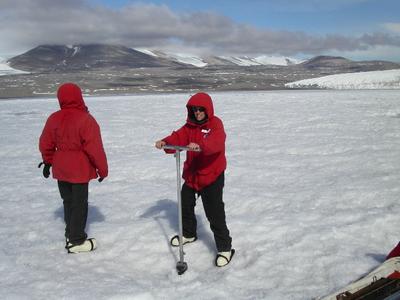3 January, 2003
Let the Boring Begin
Woke up today to a much colder tent, probably about 50 degrees, although I did not actually check it today. I just know by the number of goose bumps appearing on my body and by the amount of motivation required to crawl out of my sleeping bag.
Breakfast at 7:30. Powdered eggs and hot apple cider were available. I opted for hot cereal again. Eating is more important than ever. Food gives you energy, and therefore, allows your body to generate heat. At Happy Camper School they constantly stressed to us that if we begin to get cold, stop and eat a snack.
We all walked a short distance down to the edge of Lake Fryxell. There we picked a rock to sit on to strap on our crampons. The crampons, also known as stable icers, are just black rubber soles that are fitted with several screws that stick out as small nubs on the bottom to provide traction. It took me a trip or two onto the ice to really trust my equipment and the ability of my crampons to keep me from slipping on the ice. But I found very quickly that slipping on the ice was the least of my worries. The real fear in venturing out onto the lake is the constant threat of falling in. One would think that in Antarctica everything is frozen. WRONG. In fact the top is constantly melting under the twenty-four hour sun. So what happens around the edge of the lake, known as the moat, is that there is a thin frozen layer at the surface and then water under that for perhaps a foot or two before again reaching a layer of solid ice. So as you walk, there are many places where you can fall in. Granted, you may only fall in up to your knee, but this water is very cold. As I found out my first day, you can fall clear up to your thigh.
Today my job was to work with Sean and Aaron at boring through the ice. It is very strenuous work in that we use a manual auger to bore through five to six meters of ice, which is the equivalent of about 16-19 feet. Each hole we create in the ice takes anywhere from 45 minutes to 2 hours depending on the ice. We have a steel pipe about 4 inches in diameter with large threads on the outside like a giant hollow screw. We use this to bore into the ice and when we do, ice cores work their way up into the tube. When we first start is in reasonable work, but by the time we have four meters of tube into the hole, trying to remove ice core plugs requires a great deal of effort. Needless to say we are all getting quite a workout and at the end of the day we are exhausted.
Today we set out to bore six holes as our goal. We were only able to bore three and we were completely drained of any energy at 6:00pm when we quit. Tomorrow we hope we will do better.

Crampons on the bottom of a bunny boot. They attach with velcro straps. We must where these every time we go out onto the ice.

I have a turn at using the auger to bore into the ice. Thanks for the pre-Antarctic training Mike!
Contact the TEA in the field at
.
If you cannot connect through your browser, copy the
TEA's e-mail address in the "To:" line of
your favorite e-mail package.
|
